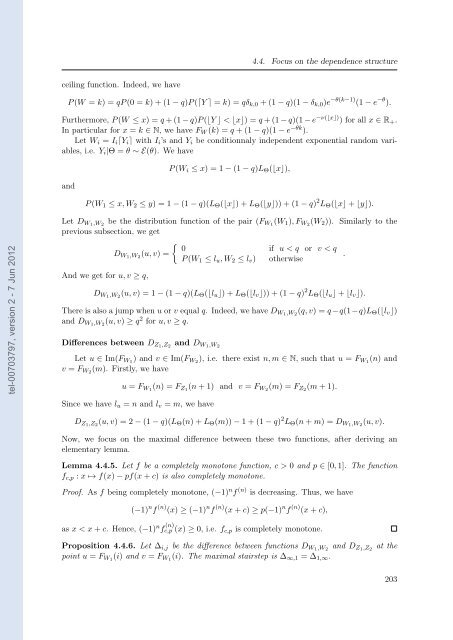Etude des marchés d'assurance non-vie à l'aide d'équilibres de ...
Etude des marchés d'assurance non-vie à l'aide d'équilibres de ...
Etude des marchés d'assurance non-vie à l'aide d'équilibres de ...
You also want an ePaper? Increase the reach of your titles
YUMPU automatically turns print PDFs into web optimized ePapers that Google loves.
tel-00703797, version 2 - 7 Jun 2012<br />
ceiling function. In<strong>de</strong>ed, we have<br />
4.4. Focus on the <strong>de</strong>pen<strong>de</strong>nce structure<br />
P (W = k) = qP (0 = k) + (1 − q)P (⌈Y ⌉ = k) = qδk,0 + (1 − q)(1 − δk,0)e −θ(k−1) (1 − e −θ ).<br />
Furthermore, P (W ≤ x) = q + (1 − q)P (⌊Y ⌋ < ⌊x⌋) = q + (1 − q)(1 − e −ν(⌊x⌋) ) for all x ∈ R+.<br />
In particular for x = k ∈ N, we have FW (k) = q + (1 − q)(1 − e −θk ).<br />
Let Wi = Ii⌈Yi⌉ with Ii’s and Yi be conditionnaly in<strong>de</strong>pen<strong>de</strong>nt exponential random variables,<br />
i.e. Yi|Θ = θ ∼ E(θ). We have<br />
and<br />
P (Wi ≤ x) = 1 − (1 − q)LΘ(⌊x⌋),<br />
P (W1 ≤ x, W2 ≤ y) = 1 − (1 − q)(LΘ(⌊x⌋) + LΘ(⌊y⌋)) + (1 − q) 2 LΘ(⌊x⌋ + ⌊y⌋).<br />
Let DW1,W2 be the distribution function of the pair (FW1 (W1), FW2 (W2)). Similarly to the<br />
previous subsection, we get<br />
<br />
0<br />
DW1,W2 (u, v) =<br />
P (W1 ≤ lu, W2 ≤ lv)<br />
if u < q or v < q<br />
otherwise<br />
.<br />
And we get for u, v ≥ q,<br />
DW1,W2 (u, v) = 1 − (1 − q)(LΘ(⌊lu⌋) + LΘ(⌊lv⌋)) + (1 − q) 2 LΘ(⌊lu⌋ + ⌊lv⌋).<br />
There is also a jump when u or v equal q. In<strong>de</strong>ed, we have DW1,W2 (q, v) = q −q(1−q)LΘ(⌊lv⌋)<br />
and DW1,W2 (u, v) ≥ q2 for u, v ≥ q.<br />
Differences between DZ1,Z2<br />
and DW1,W2<br />
Let u ∈ Im(FW1 ) and v ∈ Im(FW2 ), i.e. there exist n, m ∈ N, such that u = FW1 (n) and<br />
v = FW2 (m). Firstly, we have<br />
u = FW1 (n) = FZ1 (n + 1) and v = FW2 (m) = FZ2 (m + 1).<br />
Since we have lu = n and lv = m, we have<br />
DZ1,Z2 (u, v) = 2 − (1 − q)(LΘ(n) + LΘ(m)) − 1 + (1 − q) 2 LΘ(n + m) = DW1,W2 (u, v).<br />
Now, we focus on the maximal difference between these two functions, after <strong>de</strong>riving an<br />
elementary lemma.<br />
Lemma 4.4.5. Let f be a completely monotone function, c > 0 and p ∈ [0, 1]. The function<br />
fc,p : x ↦→ f(x) − pf(x + c) is also completely monotone.<br />
Proof. As f being completely monotone, (−1) n f (n) is <strong>de</strong>creasing. Thus, we have<br />
(−1) n f (n) (x) ≥ (−1) n f (n) (x + c) ≥ p(−1) n f (n) (x + c),<br />
as x < x + c. Hence, (−1) n f (n)<br />
c,p (x) ≥ 0, i.e. fc,p is completely monotone.<br />
Proposition 4.4.6. Let ∆i,j be the difference between functions DW1,W2 and DZ1,Z2 at the<br />
point u = FW1 (i) and v = FW1 (i). The maximal stairstep is ∆∞,1 = ∆1,∞.<br />
203
















